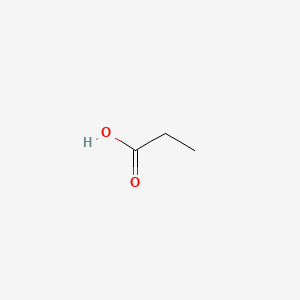propionic acid
propionic acid is a lipid of Fatty Acyls (FA) class. Propionic acid is associated with abnormalities such as Epilepsy, Infection, Tuberculosis, Alkalosis and Ischemia. The involved functions are known as Uptake, Biosynthetic Pathways, Methylation, Protein Overexpression and Biochemical Pathway. Propionic acid often locates in Body tissue, Cytoplasmic matrix, Membrane, Protoplasm and Extracellular. The associated genes with propionic acid are TRIO gene, TRRAP gene, SLC5A8 gene, SLC33A1 gene and Homologous Gene. The related lipids are Fatty Acids, Propionate, butyrate, Valerates and mycocerosic acid.
Cross Reference
Introduction
To understand associated biological information of propionic acid, we collected biological information of abnormalities, associated pathways, cellular/molecular locations, biological functions, related genes/proteins, lipids and common seen animal/experimental models with organized paragraphs from literatures.
What diseases are associated with propionic acid?
propionic acid is suspected in Propionic acidemia, Ischemia, Infection, Ulcerative Colitis, Alkalosis, Methylmalonic acidemia and other diseases in descending order of the highest number of associated sentences.
Related references are mostly published in these journals:
| Disease | Cross reference | Weighted score | Related literature |
|---|
Possible diseases from mapped MeSH terms on references
We collected disease MeSH terms mapped to the references associated with propionic acid
PubChem Associated disorders and diseases
What pathways are associated with propionic acid
There are no associated biomedical information in the current reference collection.
PubChem Biomolecular Interactions and Pathways
Link to PubChem Biomolecular Interactions and PathwaysWhat cellular locations are associated with propionic acid?
Visualization in cellular structure
Associated locations are in red color. Not associated locations are in black.
Related references are published most in these journals:
| Location | Cross reference | Weighted score | Related literatures |
|---|
What functions are associated with propionic acid?
Related references are published most in these journals:
| Function | Cross reference | Weighted score | Related literatures |
|---|
What lipids are associated with propionic acid?
Related references are published most in these journals:
| Lipid concept | Cross reference | Weighted score | Related literatures |
|---|
What genes are associated with propionic acid?
Related references are published most in these journals:
| Gene | Cross reference | Weighted score | Related literatures |
|---|
What common seen animal models are associated with propionic acid?
There are no associated biomedical information in the current reference collection.
NCBI Entrez Crosslinks
All references with propionic acid
Download all related citations| Authors | Title | Published | Journal | PubMed Link |
|---|---|---|---|---|
| Rosell CM et al. | Experimental approach to optimize the use of alpha-Amylases in breadmaking. | 2001 | J. Agric. Food Chem. | pmid:11409995 |
| Shigematsu N et al. | Effect of administration with the extract of Gymnema sylvestre R. Br leaves on lipid metabolism in rats. | 2001 | Biol. Pharm. Bull. | pmid:11411567 |
| Etchebehere C et al. | Comamonas nitrativorans sp. nov., a novel denitrifier isolated from a denitrifying reactor treating landfill leachate. | 2001 | Int. J. Syst. Evol. Microbiol. | pmid:11411724 |
| Popović DM et al. | Artificial cytochrome b: computer modeling and evaluation of redox potentials. | 2001 | J. Am. Chem. Soc. | pmid:11414837 |
| Pintsch T et al. | Cytosolic acidification as a signal mediating hyperosmotic stress responses in Dictyostelium discoideum. | 2001 | BMC Cell Biol. | pmid:11415467 |
| Gonzalo MA et al. | Fixed drug eruption due to naproxen; lack of cross-reactivity with other propionic acid derivatives. | 2001 | Br. J. Dermatol. | pmid:11422076 |
| Brock M et al. | 2-Methylisocitrate lyases from the bacterium Escherichia coli and the filamentous fungus Aspergillus nidulans: characterization and comparison of both enzymes. | 2001 | Eur. J. Biochem. | pmid:11422389 |
| Zheng S et al. | Study on sludge expansion during treatment of salad oil manufacturing wastewater by yeast. | 2001 | Environ Technol | pmid:11424730 |
| Zarić SD et al. | Factors determining the orientation of axially coordinated imidazoles in heme proteins. | 2001 | Biochemistry | pmid:11425320 |
| Topping DL and Clifton PM | Short-chain fatty acids and human colonic function: roles of resistant starch and nonstarch polysaccharides. | 2001 | Physiol. Rev. | pmid:11427691 |
| Takahashi N and Sato T | Preferential utilization of dipeptides by Porphyromonas gingivalis. | 2001 | J. Dent. Res. | pmid:11437213 |
| Breitling-Utzmann CM et al. | Identification and quantification of phosphatidylethanolamine-derived glucosylamines and aminoketoses from human erythrocytes--influence of glycation products on lipid peroxidation. | 2001 | Arch. Biochem. Biophys. | pmid:11437356 |
| Richard JP et al. | Effect of an E461G mutation of beta-galactosidase (Escherichia coli, lac Z) on pL rate profiles and solvent deuterium isotope effects. | 2001 | Bioorg. Chem. | pmid:11437390 |
| Martin AC et al. | The roles of the multiple CheW and CheA homologues in chemotaxis and in chemoreceptor localization in Rhodobacter sphaeroides. | 2001 | Mol. Microbiol. | pmid:11442826 |
| Johansson BG et al. | Release rates for pine sawfly pheromones from two types of dispensers and phenology of Neodiprion sertifer. | 2001 | J. Chem. Ecol. | pmid:11446297 |
| Schenkirsch G et al. | [Ten-year trend of analgesic drug use (1984 to 1995): results of three MONICA-based surveys in Augsburg)]. | 2001 | Dtsch. Med. Wochenschr. | pmid:11450622 |
| Herrmann AP et al. | Degradation of natural polyphenols by methanogenic consortia enriched from digested municipal sludge. | 2001 | Water Res. | pmid:11456154 |
| Hood CR and Randall AA | A biochemical hypothesis explaining the response of enhanced biological phosphorus removal biomass to organic substrates. | 2001 | Water Res. | pmid:11456176 |
| Tetteh GL and Beuchat LR | Sensitivity of acid-adapted and acid-shocked Shigella flexneri to reduced pH achieved with acetic, lactic, and propionic acids. | 2001 | J. Food Prot. | pmid:11456206 |
| Tateoka R et al. | Significance of substrate hydrophobicity for recognition by an oligopeptide transporter (PEPT1). | Bioconjug. Chem. | pmid:11459451 |
